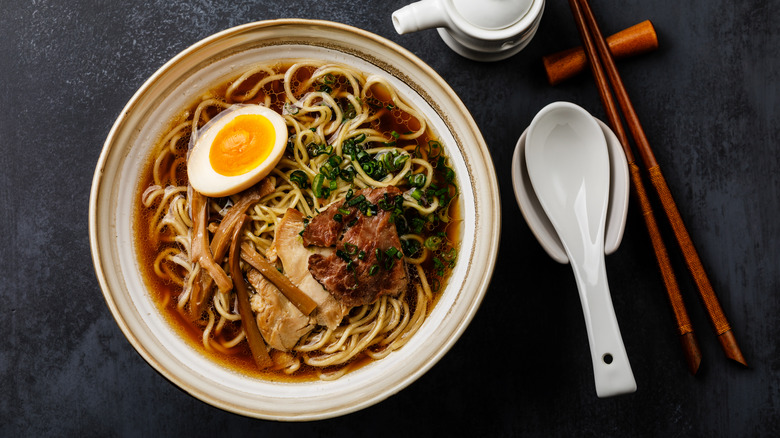Yakamein: The Cajun-Flavored Noodle Soup With Rich Cultural Roots
If you've ever loved a comforting bowl of ramen or lo mein or had your senses delighted by a rich Cajun dish, you need to meet yakamein. An irresistible combination of hot noodle soup and finger-licking Cajun spices, yakamein is a New Orleans dish that surprisingly flies under the radar for many visitors standing in line for the beignets or gumbo. yakamein goes by another name – Old Sober – due to its infamy as the perfect hangover cure. Skip the breakfast sandwich after a night out on Bourbon Street and do it the authentic New Orleans way: Find yourself a bowl of yakamein.
Yakamein has many variations but is usually made up of spaghetti, beef broth, chopped chuck roast, soy sauce, hot sauce, and a spice mix. You heard that right — yakamein foregoes traditional Asian noodles found in soups and stir-fries for spaghetti, making for a thick, perfectly slurpable partner to the hearty broth. You've never tasted broth like this before, as the spices kick things up a notch with plenty of heat to zap your sinuses back to reality. Top the protein-packed soup with a hard-boiled egg and green onions, and you've got yakamein. Just one slurp has the potential to be the most flavorful, jam-packed bite you've ever taken.
The secret sauce – or spice – of yakamein
Take a trip to New Orleans for the Jazz and Heritage Festival, and you'll surely find a booth with Ms. Linda Green, the definitive queen of New Orleans yakamein, serving up her famous take on the noodle soup. A bowl of yakamein is a whole meal in and of itself, with the melt-in-your-mouth braised chuck roast and other hearty ingredients. But what makes it truly memorable is the juice, also known as the spice and sauce combination that seasons the soup and leaves you licking your lips in anticipation for more.
But what's in the Cajun spice mix, or "the juice," that makes Chef Green's yakamein the best? Typically, a combination of soy, oyster, Worcestershire sauce, and a Cajun spice blend is the suggestion of most copycat recipes. But the true recipe is a secret Chef Green holds close to the vest. She doesn't have a flagship store or restaurant, so you'll have to catch her popping up at various festivals and soul food events around the city where you can try her version. Until then, you can try getting close by making it home.
Where yakamein came from and where to find it now
Yakamein's origins are a bit fuzzy, considering it's a unique blend of Chinese and Creole cuisine. However, one popular theory involves Chinese railroad workers brought to work in the city in the 1800s putting their heads together with local enslaved Africans cooking Creole cuisine. After all, the namesake yakamein is a variation on the Chinese noodle dish yat gaw mein. Lucky for us, the collaboration resulted in a flawless, irresistible creation.
If you don't have the good fortune of happening upon one of Chef Linda Green's pop-ups, just find a few local corner stores in New Orleans, and you'll get to sample different variations of authentic yakamein. Proteins or broth types are often swapped in and out, as well as variations on toppings. Yakamein, after all, is a prized dish for the communities in New Orleans, with recipes passed down through generations of cooks in households throughout the city. Once you get the chance to try yakamein in New Orleans, you'll be jumping at the opportunity to have another bowl and attempt to recreate this delicacy of comfort soul food for yourself.


